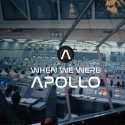For the uninitiated
From 1959 to about the mid 1970s NASA was the name most synonymous with civilian space exploration, education, discovery. From President John F. Kennedy’s bold initiative to, “Send a man to the moon and return him home safely.” A mission the entire nation was more than happy to get behind since the zeitgeist was to beat the Russians to the moon in that new type of “war” that had begun, and its most immediate by-product: the space race. This documentary chronicles how the Apollo agenda united us, and how, once we accomplished President Kennedy’s promise, “in style” as one NASA operator described the public interest would begin to weign by Apollo 16 making Apollo 17 the last mission NASA launched that still set men on the lunar surface.
Now that you’re caught up
This documentary opens on a poignant note about how NASA got its engineering roots: with German forces surrendering at the end of WWII either to Russian or United States forces. Von Braun, as we know, opted to surrender to the US forces – that reasoning can be discovered in a separate 4-part miniseries called Rocket Men. His work under the 3rd Reich was being grossly perverted into deadly powerful rockets known as the infamous V2, which leveled much of London during the height of the second world war. “The rocket performed perfectly,” Von Braun stated, “it just landed on the wrong rock,” (referring to Earth).
Under the US Army project Operation Paperclip Von Braun and several of his scientists were brought to the States, Alabama by way of Ft. Bliss, TX, to continue working and improving the V2; some of the US-based engineers already at Redstone Arsenal in Alabama were not too thrilled with the notion of working on what had essentially become the first “weapon of mass destruction.” Fortunately, Von Braun’s engineers from Germany were able to assuage the US engineers that the rockets were being converted to propulsion vehicles for space flight, not for militarization. The chief sentiment among the Germans working the project was that this project offered a means of redeeming the image of Germany following the war and the atrocities committed at the hands of Hitler and the 3rd Reich.
When the Russians successfully launched Sputnik 1, the first man-made satellite, in October of 1957 into low-Earth orbit it lit a fire under the US to catch up; our first successful launch was with the Redstone rocket – Juno 1, a four-stage rocket that launched Explorer 1 as part of Project Vanguard; six months later President Eisenhower would officially create NASA and an initial 4600+ civilian jobs and more than a decade of job security. Many of the testimonies from the documentary declare how the initiative to get ahead of the Communist super-power stirred our nation – if only we didn’t require a war to achieve the same sense of unity.
One of the more fascinating segments of the documentary was how it described the evolution of the V-2 into the Saturn V(5): an initial-stage, liquid-propellant rocket first used strictly as a long-range missile vehicle that, with a change in payload (bombs to satellites to eventual humans) and additional stages for longer trajectories, the transformation is nothing short of impressive.
Once the rockets were assembled they would need to be made mobile so they could be transported to launch pads that were placed far enough apart to account for a minimum 50-foot radius. Seeing the pictures of NASA building what would become the Marshall Space Flight Center (MSFC), the Vehicle Assembly Plant, and so forth. They had to get the rockets from the plant to the launch pads; one of the more ingenius segments was when one of the engineers, noticing a problem with the tank that transported the rockets to their respective launch pads was getting regularly clogged by the sand that the original tracks had been made from, suggested covering the entirety of the track in river rocks to provide a buffer between the bearings on the tanks wheels and the ground itself – that method has remained in place since.
With MSFC at operational capacity President Kennedy signed Executive Order 10925 in March 1961, out of which gave us pivotal historical figures like Mary Jackson, Dorothy Vaughn, and Katherine G. Johnson featured in the 2016 hit Hidden Figures. Then, in late November of 1963, President Kennedy’s assassination would send shockwaves through NASA as not only were those direct beneficiaries of EO-10925 but all of NASA (an almost purely civilian agency) left in a state of concern for their jobs and livelihood. “His dream had become our dream.”
Thankfully Kennedy’s successor, Vice-President-to-be-President Johnson, was also moved by the vision enough to maintain it. So moved was Johnson about the space program he would have Cape Canaveral renamed to Cape Kennedy. With those jobs kept secure it was back to work for NASA, and if The Shining taught us anything it’s that, “All work and no play makes Jack a dull boy.” So, where do a bunch of civilian operators and engineers go to let off all that steam? Why, The Mouse Trap! A veritable who’s who of NASA showed up there to rub shoulders, and no matter your role at NASA – from the lowliest janitor to some prospective astronauts to the many different administrators and program directors – the environment was exceedingly inclusive as long as you were at NASA.
With technology on the cutting-edge hard lessons were learned almost daily, some lessons were harder and more costly than others. Apollo 1 was easily in the top 5 of hardest learned lessons with the lives of Gus Grissom, Ed White, and Roger Chaffie being consumed in a fire believed to have been caused by an electrical spark from their communication equipment in a pure-oxygen environment. Considerations like including Nitrogen in the Oxygen to better simulate real air and reduce the presence of a volatile breathing environment, having an access hatch that opens outwards instead of inwards, and the materials of the capsule itself. In the 2019 biography on Armstrong, even he called it an indictment on everyone at NASA. One of the “gifts” that came from that tragedy was flow-charts for electrical diagrams. Before then it was one engineer’s interpretations of another’s electrical symbolism – very little in the way of a concrete standard to work with where the complicated electrical systems of spacecraft was concerned.
Apollo 3 would become the first victorious Apollo unmanned flight making Apollo 7 the first successful Apollo manned-flight; much of the first six flights were unmanned for testing the Saturn I – V rockets themselves. By Apollo 4, as a nation, we were deeply embroiled in the Vietnam War, Dr Martin Luther King Jr was assassinated, we needed a victory to keep national morale up. “People weren’t being forced to work those long hours,” stated one operator, incidentally reaffirming Mark Armstrong’s sentiments about his own father’s long hours at Marshall, “A lot of divorces here at NASA.” Life went on indeed: another operator reported that he only got to mee his 4th son briefly over teleconference to the hospital remotely from work. For the 60s that’s both sad and also kind of cool, from a technology perspective. Yet another operator recalls learning of his father’s death shortly following a meeting regarding Apollo 10.
While all that life is happening around NASA’s team the agents are clearly divided between losing that quality time with their own families versus the great firsts that they were experiencing as a direct benefit of working there: Apollo 8, on December 24th 1968, brought back the first images of the view of the earth from the moon… riveting, if even such a word is adequate. Today, we see those sorts of images after a simple Google search, but in those days that imagery was merely the work of speculative sci-fi writers and illustrators.
By Apollo 11 the program was in full swing and had reached a few successful manned missions with the Saturn V rocket; what made this documentary really sweet was the inclusion of all the archived photos between Apollo 11 itself and the documentation never before seen, even in the 2019 Armstrong biography. Seeing the plague left on the moon by the first three men, “Here men from the planet Earth first set foot upon the Moon July 1969, A.D. We came in peace for all mankind.”
The job security for the civilian operators was solid during the days of Gemini, Mercury, and Apollo; however, as one operator put it, “The lack of enthusiasm was clear by Apollo 16 as the attendance for that launch was not even half of what Apollo 11 had been.” We had not only achieved Kennedy’s goal of beating Russian to the moon, but we had done so in style,” but again, “now, we had no answer or vision of where to go next.”
It didn’t take long for the National budget’s consideration to lose sight of NASA now that we had put a man on the moon. By Apollo 12 NASA was already being forced to downsize on account of budget cuts. Some would suggest that those budget cuts were felt as early as Apollo 13 with Jim Lovell’s famous line, “Houston, we have a problem,” and the crew’s having to treat the return Lunar Module as a veritable “life boat” to return to Earth safely. Fortunately, Apollo 14 got that mission taken care of, but the point was sadly clear. NASA’s days with Apollo were officially numbered.
Apollo 17 would go on to be the last Apollo mission carrying on it a professional geologist Eugene Cerna – the last US citizen to walk on the moon; from there all missions were eventually scrubbed for budget concerns. Not disclosed in the documentary, but Russia would go on to be the site for future launches from their Cosmodome in Baikonur.
So, what’s to be done with all the newly acquired understanding for this new rocket science and all the resulting technology? Von Braun released a statement shortly after Apollo 17’s successful return that, in recognition of the global leadership that NASA had essentially provided, the “program would be dissolving so as to spread the gained knowledge with the rest of the world.” For what is the point of advancing science and human progress if not to share what was learned.
“Currently, we have a real focus on the individual, and that attitude is not going to cut it if we are going to go beyond ourselves. So, you go back to Apollo and you say, ‘What made it special? Why did it happen? What can we do today to put us back on track like we had?’” (Then), “Maybe, one of us will come iup with an answer; it may not be ‘the’ answer, but it’s one of ‘em. Let’s go down that road!”
Between 1961 and 72 an estimated 400,000 civilians helped achieve President Kennedy’s goal of putting 12 men on the lunar surface and returned them home safely.






